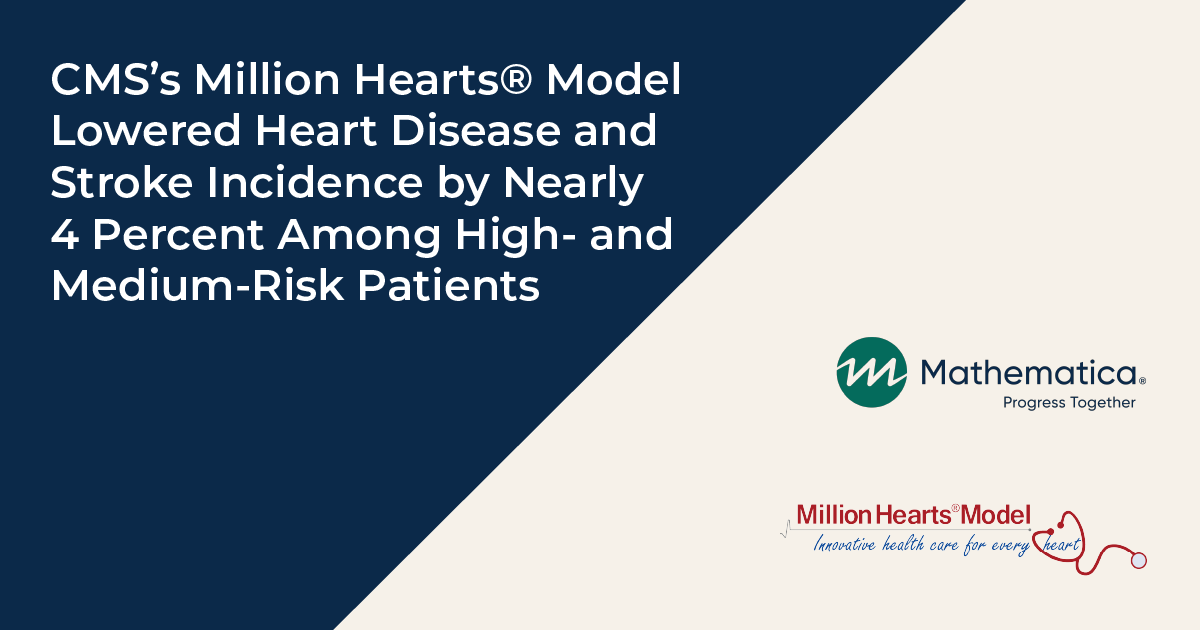A final report from Mathematica and collaborators at RAND and the University of Colorado found that the Centers for Medicare & Medicaid Services’ (CMS) Million Hearts® Cardiovascular Disease (CVD) Risk Reduction Model reduced the incidence of first-time heart attacks and strokes for high- and medium-risk Medicare beneficiaries by 3 to 4 percent and reduced the death rate by more than 4 percent. In achieving these reductions, the Million Hearts Model met its goal of decreasing the incidence of first-time heart attacks and strokes among high- and medium-risk Medicare fee-for-service (FFS) beneficiaries over five years.
“The Million Hearts Model is promising for public and private health systems seeking to improve health outcomes for CVD, the leading cause of death in the United States and worldwide,” said Greg Peterson, a principal researcher at Mathematica. “Our findings also indirectly support clinical guidelines underpinning the model’s requirements, such as the use of routine CVD risk assessment to encourage the primary prevention of CVD.”
Mathematica and RAND’s five-year randomized trial evaluation of the Million Hearts Model showed positive impacts on preventive care for CVD and cardiovascular risk factors. The findings suggest the model prevented one CVD event over five years for roughly every 250 to 400 high- and medium-risk beneficiaries enrolled, depending on the outcome definition used. An analysis in JAMA also details key findings from the evaluation.
Decreases in beneficiaries’ systolic blood pressure and low-density lipoprotein cholesterol were the primary drivers of the reduced risk of CVD. Improvements in CVD preventive care, a core component of the model, such as providers’ increased use of CVD risk assessment and beneficiaries’ increased use of statins and antihypertensive medications, drove these results.
One goal of the model was to encourage providers to calculate Medicare beneficiaries’ risk scores so they could identify and treat patients who are at the greatest risk of heart attacks and strokes before CVD events or deaths happen. Mathematica found an 82 percent increase in the share of health providers reporting they calculate CVD risk scores for at least half of their Medicare beneficiaries.
Under the model, high- and medium-risk beneficiaries were more likely to start or intensify their use of statins (by 3.5 percentage points) and antihypertensive medications (by 2.4 percentage points). Clinical guidelines for preventing CVD recommend that high-risk patients consider taking antihypertensive medications and statins, improve their diet and exercise, and stop smoking. Prior medical research has found that statins and antihypertensive medications can reduce a patient’s risk of experiencing a CVD-related event or death.
“We also found that Million Hearts can help address issues in equity for cardiovascular care,” said Malcolm Williams, senior researcher at RAND.
The model increased the use of medications more for beneficiaries living in areas with greater economic and social vulnerabilities, suggesting that model features such as universal risk stratification can help reduce disparities in CVD care and contribute to health equity. Universal risk stratification can help to ensure providers do not overlook risks in more vulnerable populations that have historically been more likely to have their risks unidentified or unaddressed.
The five-year randomized trial for the Million Hearts Model involved 345 primary care practices, specialty practices, health centers, and hospital outpatient departments throughout the country, with half randomly assigned to an intervention group and half to a control group. In 2017 and 2018, the first two years of the model, the intervention and control organizations enrolled about 382,000 Medicare beneficiaries. Under the model, CMS tested whether it could improve cardiovascular care and prevent first-time heart attacks and strokes by encouraging providers to use risk scores to guide their care and by paying providers to measure and reduce cardiovascular risks among their Medicare patients.
The Million Hearts Model is part of the broader Million Hearts initiative, co-led by the Centers for Disease Control and Prevention and CMS, which aims to prevent one million heart attacks and strokes over five years. CVD remains the leading cause of death in the United States and progress combatting the disease has stalled in recent years, with substantial room to improve modifiable risk factors.
In addition to the finding about improvements to preventive care and reductions in risk, Mathematica—along with partners at RAND and the University of Colorado—also reported the model did not measurably change per capita Medicare spending, though model payments were modest ($1.24 per beneficiary per month).
Learn more about Mathematica’s evaluation the Million Hearts Model.
Contact
-
Amy Berridge
aberridge@mathematica-mpr.com
609-945-3378


